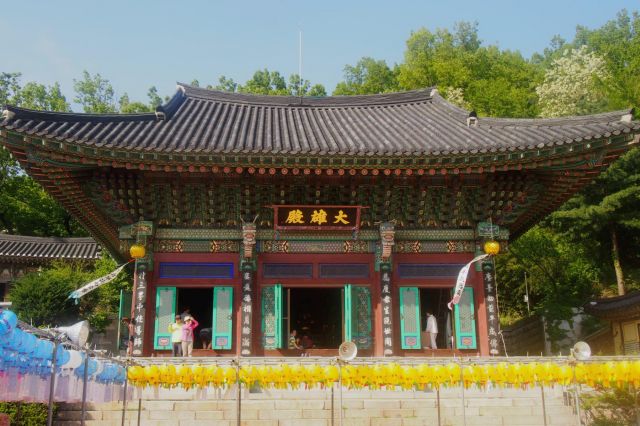[HanCinema's Korea Diaries] "Seoul" May 13th-17th
 By William Schwartz | Published on
By William Schwartz | Published on
Ah, Buddha's birthday. It's a hard holiday to miss, considering whatever random location I go to there's been some sort of elaborate display of Buddha or a pagoda or something or other. While I'm not terribly familiar with the rituals behind Buddha's Birthday, it's easy enough to appreciate scenes like this one at Cheonggyecheon (청계천), which might be better known as "that huge river in the middle of Seoul where everyone takes walks".
Advertisement
...But anyway, the real action is at the temples. Bongwonsa (봉원사) was where I paid pilgrimage- it's a major temple located quite close to Ewha University, which is where the Seoul International Agape Film Festival (SIAFF). Which seems preposterous, come to think of it. A Christian film festival during Buddha's birthday? For this blasphemy I had to climb up a very tall urban hill. Which naturally was filled with food tents and peddlers since anyone climbing up a steep hill needs an excuse to stop every once in awhile.
It's funny how for all these displays Buddha's Birthday still feels significantly less commercial than Christmas. The context helps. Observe how the meal is taken in fellowship, how the toy merchant is just a random regular guy, and that there is of course a monk requesting alms. It's good, I think, for spirituality to be experienced on an uphill slope. I suspect it's why so many of these Buddhist temples were built on hills. A lot of Christian pilgrimage sites are too in Korea. Actually, Ewha University (이대학교) is itself a Christian institution (built by Methodists) and follows the same pattern.
These are stairs in Ewha. There are many of them on this campus, so after a certain point it's easy to be mesmerized by the classical stone design. Sure it's no Buddhist Temple, but evidently the Methodists built this place to last. Of the many universities I've seen in South Korea Ewha's gyms is one of the less utilized most likely because just getting to the dormitory can be an excessive workout. A workout that builds moral character, of course.
That's something which has always impressed me about these old temples, that anyone decided to go to the effort to build them in the first place, especially considering how so many of them are located in obscure or difficult to get to locations. They really are a nice source of comfort. Imagine people in olden times, with whatever problems, being forced to move over long distances. And yet at any time they could probably find a place to pray for succor. It's kind of like McDonald's except, you know, with human faith and dignity instead of bad food.
Anyway, back to SIAFF. Here we see a staffperson prepare for a guest talk with Kim Seong-een (김성인), the general manager of 난민인권센터, the Center for Refugee's Rights (NANCEN), following a screening of Those Who Jump, a documentary which depicts African migrants trying to jump the border from Morocco into Spain. Apparently Spain has one small town in Africa. Kim Seong-een talked about, well, what you'd expect really- about how it's hard to be a migrant like in the movie and how migrants deserve compassion and mercy like what Jesus preached.
That's an element of SIAFF that I rather liked. Rather than discussing film themes in a critical theory context, the talks instead discussed movies in a Christian context. Relatively few of the movies screened at SIAFF were actually designed with a Christian audience in mind- but one of the nice parts of the Gospel is that it's easy to relate Jesus' teachings to some rather far flung situations. Refugees looking for a better life? Ant-infested trees? Stolen cell phone? Whatever the problem, compassion ends up seeming like a pretty decent solution.
For me, that's the main compelling reason to travel, or go to film festivals, or do whatever. It's not about emphasizing the differences, but finding the human similarities. In between all the festivals, film-related or otherwise, May is probably about the best time to go to Seoul for these reasons.
Article by William Schwartz
 William Schwartz
William Schwartz
Staff writer. Has been writing articles for HanCinema since 2012, having lived in South Korea from 2011 to 2021. He is currently located in the Portland metropolitan area. William Schwartz can be contacted via william@hancinema.net, and is open to requests for content in future articles.
















